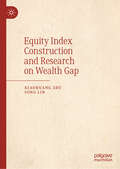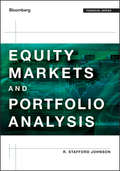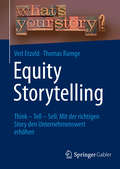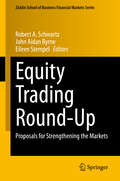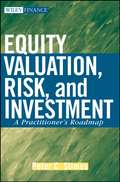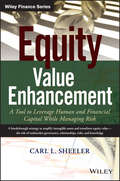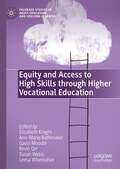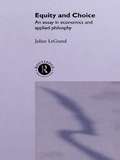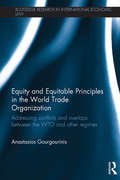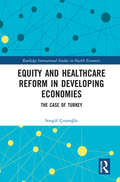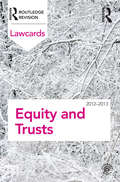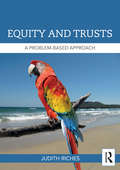- Table View
- List View
Equity Index Construction and Research on Wealth Gap
by Xiaohuang Zhu Song LinThis book constructs a Chinese Social Equality Index–the Mongoose Social Equality Index–with the wealth gap index as its core, and the legal equality index, the socio-cultural equality index, and the financial equality index as its supplement. The book focuses on the influence of the wealth gap on economic and social issues. Empirical research shows that there are three turning points in the influence of the wealth gap index on economic growth: discrepancy turning point, golden turning point and destructive turning point. Based on the latest data,the current expected wealth gap index in China has surpassed the destructive point. This means that wealth brought about by economic growth will largely go to the rich, which aggravates inequality and even brings forth a potential economic recession. Meanwhile, the index also indicates that, as the Chinese economy develops, social equality has been on a noticeable decline. This book will be of interest to economists, China watchers, and political scientists
Equity International: The Second Act
by Nicolas P. Retsinas Ricardo Reisen de Pinho Ben CreoThomas McDonald, senior vice president of Equity International, is weighing an investment in the Brazilian homebuilder Gafisa. Was this the right country? The right company? The right co-investor? The right time? McDonald would be investing alongside a Brazilian private equity firm, GP Investments, and must decide how to structure the investment. Especially, he must decide how to align his interests with those of GP. GP has recruited EI due to its prior experience with the Mexican homebuilder Homex. McDonald must also consider: Is that experience transferable to this investment?
Equity Markets and Portfolio Analysis
by R. Stafford JohnsonUnderstand today's investment challenges and the role of the Bloomberg systemIn recent years, changes have swept through the investment industry like wildfire. Academia has followed along and provided new lenses for viewing this transformation, as well as new strategies for gaining a true understanding and knowledge of investment and financial markets. Now, Equity Markets and Portfolio Analysis has been created to further inform investment professionals and finance students on the basic concepts and strategies of investments, and to provide more detailed discussions on advanced strategies and models. The concepts covered in this book will help readers gain a better understanding of the markets and uses for an increasing number of securities, strategies, and methodologies.Equity Markets and Portfolio Analysis is the only core investment book that covers the functionality of Bloomberg terminals, increasingly critical tools both in the classroom and on the trading floor. As Bloomberg terminals now play a key role in the research, teaching, and managing of student investment funds, understanding the system's information and analytical functions has become more important than ever.In-depth coverage of fundamentals through more detailed concepts for students and professionals who want to better understand the evaluation, selection, and management of securitiesOne-of-a-kind training and instructional course, introduction to Bloomberg investment subjects, and reference for CFA preparationBloomberg material provided in an appendix accompanying each chapter, a useful option for professorsIdeal for finance practitioners, investment bankers, and academicsThis unique resource will give readers both the foundational knowledge and the analytical tools necessary for investment success, both in the classroom and in the real world.
Equity Markets in Transition
by Robert A. Schwartz Reto FrancioniThis book underscores the complexity of the equity markets, the challenges they face, and the fact that they are still a work in process. Three interacting forces drive market change: competition, technology change, and regulatory change. The markets have one major objective in particular to achieve: the delivery of accurate price discovery for both traders and the broader market. Are we getting it? Are competition, technology, and regulation acting together to improve market quality, or are they adding to the complexity of the markets and making accurate price discovery harder to achieve? The difficulty of addressing these issues and reaching a consensus regarding public policy is reflected in the diverse opinions expressed in this book. From an institutional perspective, the volume's contributors highlight the interconnectedness of all aspects of the internal and external environment within which exchange organizations act. Equity Markets in Transition underscores how technological evolution and recent regulatory changes have influenced the business, and how these developments have opened new possibilities for exchange organizations and for equity markets as a whole, including such issues as the impact of equity markets on job creation. The book combines both a theoretical and a practical approach. Part I presents a theoretical overview of the international equity market business, including an overall description of the value chain of stock trading that includes deep dives on every decisive step. Part II contains contributions from various business specialists who have specific practical and academic knowledge of the different steps. Equity Markets in Transition represents a unique combination of theoretical and practical analysis that offers first-hand insights on all relevant interactions and interrelations among the various parts of the exchange business, with an emphasis on facilitating analysis of the status quo and of emerging trends regarding business models, regulation, and the development of the competitor, customer and investor sides.
Equity Markets, Valuation, and Analysis (Wiley Finance)
by H. Kent Baker Halil Kiymaz Greg FilbeckSharpen your understanding of the financial markets with this incisive volume Equity Markets, Valuation, and Analysis brings together many of the leading practitioner and academic voices in finance to produce a comprehensive and empirical examination of equity markets. Masterfully written and edited by experts in the field, Equity Markets, Valuation, and Analysis introduces the basic concepts and applications that govern the area before moving on to increasingly intricate treatments of sub-fields and market trends. The book includes in-depth coverage of subjects including: · The latest trends and research from across the globe · The controversial issues facing the field of valuation and the future outlook for the field · Empirical evidence and research on equity markets · How investment professionals analyze and manage equity portfolios This book balances its comprehensive discussion of the empirical foundations of equity markets with the perspectives of financial experts. It is ideal for professional investors, financial analysts, and undergraduate and graduate students in finance.
Equity Release Finance (Chapman and Hall/CRC Financial Mathematics Series)
by Radu S. Tunaru Enoch B. QuayeEquity Release Finance provides a self-contained introduction to the principles underpinning Equity Release Products (ERPs). The approach of the book, while academically robust, is also accessible and engaging, with a focus on practical examples and applications. It will provide an invaluable resource to a diverse audience, including Master’s degree and PhD students in finance, management science, actuarial science, and risk management. It will also be of service to academics and industry professionals.Features A strong practical focus makes this an effective reference for industry professionals in the field of insurance, pensions, derivatives, and risk management Replete with pedagogical features, the book can be used to teach Master’s and/or PhD level graduate students The ideas presented in this book should be of interest to policy makers and regulators interested in developing a viable stable market, opening many avenues for further research in this area
Equity Smart Beta and Factor Investing for Practitioners
by Ronan G. Heaney Stephen C. Platt Khalid GhayurA guide to the popular and fast growing investment opportunities of smart beta Equity Smart Beta and Factor Investing for Practitioners offers a hands-on guide to the popular investment opportunities of smart beta, which is one of the fastest growing areas within the global equity asset class. This well-balanced book is written in accessible and understandable terms and contains an in-depth manual filled with analytical information and new ideas. The authors—noted experts in the field—include a definition of smart beta investing and detail its history. They also explore the distinguishing characteristics of smart beta strategies, offer an overview of factor investing, and reveal the implementation of smart beta approaches. Comprehensive in scope, the book contains helpful examples of applications, real-life illustrative case studies, and contributions from leading and respected practitioners that explain how they approach smart beta investing. This important book: Contains an in-depth exploration of smart beta investing Includes the information written in clear and accessible language Presents helpful case studies, illustrative examples, and contributions from leading and respected experts Offers a must have resource coauthored by the Head of Goldman Sachs’ equity smart beta business Written for investors who want to tap into the opportunities that smart beta offers, Equity Smart Beta and Factor Investing for Practitioners is the comprehensive resource for learning how to create more efficient overall equity portfolios.
Equity Storytelling
by Veit Etzold Thomas RamgeEine gute Story macht ein Unternehmen greifbar. Sie regt die Fantasie an. Denn der Mensch liebt Geschichten. Bei Unternehmenstransaktionen ist eine spannende Equity Story ein mächtiger Hebel, den Wert zu erhöhen. Der Preis steigt, wenn Investoren, Investmentbanker und Business Angels die Equity Story im Wortsinn abkaufen. Umso erstaunlicher ist: Viele Verkäufer von Unternehmensanteilen verzichten darauf, die Mittel des Storytellings für ihre Zwecke zu nutzen. Dabei gilt auch im Kontext von Mergers & Acquisitions, Private Equity und Venture Capital: Eine gute Equity Story ist mehr als glänzende Power Point-Präsentationen, optimistische Zahlungsströme und komplexe Excel-Sheets. Equity Storytelling ist kreatives Handwerk, verbunden mit analytisch-strategischer Grundkompetenz. Das Standardwerk für alle, die Unternehmen oder Unternehmensteile kaufen und verkaufen.
Equity Trading Round-Up: Proposals for Strengthening the Markets (Zicklin School of Business Financial Markets Series)
by Robert A. Schwartz John Aidan Byrne Eileen StempelThis book examines the complexity of trading and the creation of liquidity. Titled after the Baruch College Financial Markets Conference, Equity Market Round-Up: Proposals for Strengthening the Markets, this book explores how regulation has a clear impact on market structure and, therefore, how market structure impacts efficient trading and capital formation. The following questions are analyzed: What are the liquidity strategies for pricing and interacting? Is liquidity any more available today for an illiquid stock than it was on the floor of the exchange 20 years ago? How do we cope with the dynamics of a continuous market? How can market structure be improved? What are the effects of high frequency trading? The Zicklin School of Business Financial Markets Series presents the insights emerging from a sequence of conferences hosted by the Zicklin School at Baruch College for industry professionals, regulators, and scholars. The transcripts from the conferences are edited for clarity, perspective and context; material and comments from subsequent interviews with the panelists and speakers are included for a complete thematic presentation. Each book is focused on a well delineated topic, but all deliver broad insights into the quality and efficiency of the U.S. equity markets and the dynamic forces that are changing them.
Equity Valuation and Portfolio Management
by Harry M. Markowitz Frank J. FabozziA detailed look at equity valuation and portfolio management Equity valuation is a method of valuing stock prices using fundamental analysis to determine the worth of the business and discover investment opportunities. In Equity Valuation and Portfolio Management Frank J. Fabozzi and Harry M. Markowitz explain the process of equity valuation, provide the necessary mathematical background, and discuss classic and new portfolio strategies for investment managers. Divided into two comprehensive parts, this reliable resource focuses on valuation and portfolio strategies related to equities. Discusses both fundamental and new techniques for valuation and strategies Fabozzi and Markowitz are experts in the fields of investment management and economics Includes end of chapter bullet point summaries, key chapter take-aways, and study questions Filled with in-depth insights and practical advice, Equity Valuation and Portfolio Management will put you in a better position to excel at this challenging endeavor.
Equity Valuation, Risk and Investment
by Peter C. StimesAuthor Peter Stimes's analysis of the investment process has long been inspired by some of the best minds in the world of finance, yet some of the ways in which he approaches this discipline are truly unique. In Equity Valuation, Risk, and Investment, Stimes shares his extensive expertise with you and reveals how practitioners can integrate and apply both the theory and quantitative analysis found in finance to the day-to-day decisions they must make with regard to important investment issues.
Equity Value Enhancement
by Carl L. SheelerA detailed look at risk identification and value creation in private equity investment Equity Value Enhancement ("EVE"): Governance, Risk, Relationships & Knowledge ("GRRK") provides the information and tools practitioners and business owners need to work with the multitude of intangibles ("GRRK") in equity investment decisions. The author engages readers with an insightful and brief claim: "Values are more than numbers." He then provides support for just how important human capital is to the value creation paradox. He doesn't stop there because ideas without definitive actions don't promote transformation. He further challenges the reader with: "If you don't think outside of the box, you're doomed to live in the box."A user-friendly manual chock full of vignettes, suggestions and pithy commentary EVE is a must read for owners, officers, boards and advisors to derive understanding of business value drivers. This book teaches the reader how to conduct more intangible asset due diligence as well as what decisions and behaviors impact value. With more effective methods of risk identification, measurement, management, and mitigation ("IMMM"), trusted advisors and owners can establish a "working on the business" strategy to prioritize issues impacting a company's intangible assets - assets which almost inevitably create the largest component of value in flourishing companies. This focus also serves to reduce risk while leveraging human capital and operational effectiveness. This book challenges users of value enhancement and valuation services to demand greater intellectual rigor to best serve owners/investors of the United States' economic engine--the midmarket company. Therefore, readers are challenged to look beyond the common metrics and numbers. They are admonished to rely less on formulaic approaches and on software that can generate spurious opinions. The reader is called to action by the author, a US Marine Combat Officer veteran, to lead the change: "You burn the boats if you want to be sure you succeed taking the island."Trillions of dollars of private equity are changing hands as Baby Boomer owners and investors seek greater liquidity and legacies while investors seek higher returns from direct investment in private companies. This book provides risk and human capital guidance removing some of the guesswork on valuation and value creation. * Provide better evidence of value & equity discounts* Identify and quantify risk and provide tools to manage it* Inform better business management and investment decisions* Create a more comprehensive valuation for equity investments* Roadmap and strategy for enhancement of going concern valueGovernance, Risk and Compliance ("GRC") management are hot topics in today's economic environment. The familiar financial metrics may not be providing adequate indications of value creation - the core principle of most shareholder investment expectation. To identify risk and work with it effectively, practitioners need an in-depth understanding of the forces at play. Equity Value Enhancement is a detailed, insightful guide for making better equity decisions. Finally, the author puts his passion front and center by offering the reader the opportunity to invest in the human capital this book addresses by encouraging support of military veteran's with combat PTSD so they may be productive citizens with the leadership and business skills provided by our country's "Greatest Generation."
Equity and Access to High Skills through Higher Vocational Education (Palgrave Studies in Adult Education and Lifelong Learning)
by Ann-Marie Bathmaker Kevin Orr Gavin Moodie Leesa Wheelahan Elizabeth Knight Susan WebbThis book explores new and distinctive forms of higher vocational education across the globe, and asks how the sector is changing in response to the demands of the 21st century. These new forms of education respond to two key policy concerns: an emphasis on high skills as a means to achieve economic competitiveness, and the promise of open access for adults hitherto excluded from higher education. Examining a range of geographic contexts, the editors and contributors aim to address these contexts and highlight various similarities and differences in developments. They locate their analyses within the various political and socio-economic contexts, which can make particular reforms possible and achievable in one context and almost unthinkable in another. Ultimately, the book promotes a critical understanding of evolving provisions of higher vocational education, refusing assumptions that policy borrowing from apparently ‘successful’ countries offers a straightforward model for others to adopt.
Equity and Adequacy in Education Finance: Issues and Perspectives
by National Research CouncilSpending on K-12 education across the United States and across local school districts has long been characterized by great disparities--disparities that reflect differences in property wealth and tax rates. For more than a quarter-century, reformers have attempted to reduce these differences through court challenges and legislative action. As part of a broad study of education finance, the committee commissioned eight papers examining the history and consequences of school finance reform undertaken in the name of equity and adequacy. This thought-provoking, timely collection of papers explores such topics as: What do the terms "equity" and "adequacy" in school finance really mean?How are these terms relevant to the politics and litigation of school finance reform?What is the impact of court-ordered school finance reform on spending disparities?How do school districts use money from finance reform?What policy options are available to states facing new challenges from court decisions mandating adequacy in school finance?When measuring adequacy, how do you consider differences in student needs and regional costs?
Equity and Choice: An Essay in Economics and Applied Philosophy
by Julian Le GrandOffering a new answer to an age-old problem: the meaning of a just or equitable distribution of resources, Julian Le Grand examines the principal interpretations of equity used by economists and political philosophers. He argues that none captures the essence of the term as well as an alternative conception relating equity to the existence or other
Equity and Efficiency in the Reform of Price Subsidies
by Sanjeev Gupta Robert Gillingham Juan Pablo CordobaA report from the International Monetary Fund.
Equity and Equitable Principles in the World Trade Organization: Addressing Conflicts and Overlaps between the WTO and Other Regimes (Routledge Research in International Economic Law)
by Anastasios GourgourinisThis book analyses whether, and how, equity and equitable principles can be employed as juridical tools in the legal reasoning of judges and lawyers in World Trade Organization (WTO) disputes where there is interaction between norms derived from the multilateral trade regime and other international legal regimes. Bringing the literature on equity and equitable principles in international law up to date this book tackles several legal problems which have emerged in WTO dispute settlement practice as well as engaging with the concept of the fragmentation of international law. The book provides an original argument about the role and significance of equity and equitable principles in the debate over fragmentation by providing a coherent methodology for addressing conflicts and overlaps between WTO and non-WTO norms in the context of Dispute Settlement Body proceedings.
Equity and Growth in a Globalizing World
by Michael Spence Ravi KanburWhat has been the evolution of poverty and equity during the recent globalizing decades? How have poor countries fared on the Millennium Development Goals? What role does wealth inequality play in the level and efficiency of investment and, hence, in economic growth? Is gender equity a smart pro-growth strategy as well as a pro-poor one? How is equality different from equality of opportunity, and should policy makers pursue one, the other, or both? In formulating distributional strategies, should the middle class be integrally considered, or should the focus be entirely on the poorest of the poor? What are the precise impacts of globalization on poverty and equity, and what are the policy implications of these impacts? Is the problem with globalization that a key element is missing-the globalization of labor employment? What is the role of international migration in the evolution of equity within and between nations? This book has been prepared for the Commission on Growth and Development to evaluate the state of knowledge on the relationship between poverty, equity, and globalization. It considers a range of questions on poverty and equity within nations, and the policy frameworks that can best address distributional concerns as the basis for a growth strategy. It also examines the important issue of equity between nations, in particular the possible role of international migration in alleviating this inequity. Written by prominent analysts in their fields, 'Equity and Growth in a Globalizing World' seeks to create a better understanding of the interactions between globalization, growth, and different dimensions of equity and poverty, and to inform policy makers of possible policy levers to address central concerns in the debates in this area.
Equity and Healthcare Reform in Developing Economies: The Case of Turkey (Routledge International Studies in Health Economics)
by Songül ÇınaroğluEnsuring equity in healthcare is the main concern of health policymakers in order to provide a sustainable health system. This concern is more prominent in developing countries due to the scarcity of resources. This book provides a comprehensive analysis and discussion on the distributive pattern of out-of-pocket pharmaceutical expenditures under the health reforms in Turkey and makes comparisons with pharmerging countries. Turkey’s health reforms began in 2003 to address shortcomings related to financial protection and to improve health outcomes and the quality of healthcare services. The primary motivation was to ensure equity in the distribution of health resources, and this transformation process led to profound changes in how these resources were used, and in health financing in general. However, there is a lack of knowledge regarding the long-term effect of health reforms on the distribution patterns of health expenditures and health service use. This book offers a thorough equity analysis of the health financing system, affected by this health transformation program. Index and curve approaches are used in the equity analysis of pharmaceutical expenditures. The book examines the long-term effects of health system regulations on the health spending characteristics of households and improves the current understanding of equity in this context. It includes extensive international comparisons of healthcare services across a range of developing countries and highlights the significance of ensuring equity for emerging economies. The author explores the existing evidence as well as future research directions and provides policy and planning advice for health policymakers to contribute to establishing a more equal health system design. Additionally, the book will be of interest to scholars and professionals in the fields of health economics, public health management and health financing.
Equity and Sustainability (Approaches to Global Sustainability, Markets, and Governance)
by David Crowther Shahla SeifiThis book delves into the multifaceted concept of sustainability, placing a particular emphasis on the social dimension and its intersection with economic and environmental considerations. It examines how individuals, corporations, and institutions can adapt their behaviors to align with sustainable practices. Through a global perspective, the book explores various aspects of behavior changes required for sustainability, highlighting diverse approaches adopted in different regions around the world. One of the central themes explored in this book is the notion of equity in sustainability. While it is acknowledged that complete equality is unattainable, the book argues that achieving fairness in outcomes is essential for the stability and longevity of sustainable practices. Without equity, there is a risk of social unrest and instability, which could undermine the sustainability agenda. Drawing on contributions from scholars representing diverse international backgrounds, the book offers fresh perspectives and innovative solutions to the challenges of sustainability. Rooted in the tradition of the Social Responsibility Research Network (SRRNet), this book embodies the network's ethos of promoting dialogue, sharing best practices, and seeking relevant solutions. It aims to inspire new thinking and action toward a more sustainable and equitable future for all, presenting a blend of academic rigor and practical insights. Through its exploration of sustainability from a social perspective, this book contributes to the ongoing discourse on how to address the pressing global challenges of our time.
Equity and Trusts Lawcards 2012-2013 (Lawcards)
by RoutledgeRoutledge Lawcards are your complete, pocket-sized guides to key examinable areas of the undergraduate law curriculum and the CPE/GDL. Their concise text, user-friendly layout and compact format make them an ideal revision aid. Helping you to identify, understand and commit to memory the salient points of each area of the law, shouldn’t you make Routledge Lawcards your essential revision companions? Fully updated and revised with all the most important recent legal developments, Routledge Lawcards are packed with features: Revision checklists help you to consolidate the key issues within each topic Colour coded highlighting really makes cases and legislation stand out Full tables of cases and legislation make for easy reference Boxed case notes pick out the cases that are most likely to come up in exams Diagrams and flowcharts clarify and condense complex and important topics '...an excellent starting point for any enthusiastic reviser. The books are concise and get right down to the nitty-gritty of each topic.' - Lex Magazine Routledge Lawcards are supported by a Companion Website offering: Flashcard glossaries allowing you to test your understanding of key terms and definitions Multiple Choice Questions to test and consolidate your revision of each chapter Advice and tips to help you better plan your revision and prepare for your exams Titles in the Series: Commercial Law; Company Law; Constitutional Law; Contract Law; Criminal Law; Employment Law; English Legal System; European Union Law; Evidence; Equity and Trusts; Family Law; Human Rights; Intellectual Property Law; Jurisprudence; Land Law; Tort Law
Equity and Trusts: A Problem-Based Approach (Problem Based Learning)
by Judith RichesEquity and Trusts: A Problem-Based Approach creates a fresh approach to learning through the use of integrated realistic case studies designed to simulate how the law works in practice. With comprehensive coverage of the complete equity and trusts curriculum, unlike other textbooks, it integrates a thorough exposition of the legal rules with applied problem-solving opportunities, highlighting the legal issues and providing essential context for the law. The book’s goal is to familiarise students with a more active and practical approach to equity and trusts that will deepen their knowledge and understanding. Written in a clear and concise style but without sacrificing detail or analysis, Judith Riches not only provides students with a full and wide-ranging account of the law, but also helps them to develop the analytical and problem-solving skills they will need to succeed in their studies and beyond. Key features include: Case studies at the start of each chapter provide real-world context to each topic and help to familiarise readers with the legal language and style they will encounter Apply Your Learning boxes invite students to reflect and consolidate on the content covered in order to apply the law back to the case study Consider This boxes present variations to the case studies and alternative scenarios to challenge students to take their application of the law to the next level Key Cases and Statutes boxes reinforce the essential role of cases and legislation in the development and application of land law and help students identify key sources of legal authority for revision purposes Tutor Tips highlight important issues and opportunities to impress tutors and examiners without interrupting the flow of the text
Equity for Women in Science: Dismantling Systemic Barriers to Advancement
by Cassidy R. Sugimoto Vincent LarivièreThe first large-scale empirical analysis of the gender gap in science, showing how the structure of scientific labor and rewards—publications, citations, funding—systematically obstructs women’s career advancement.If current trends continue, women and men will be equally represented in the field of biology in 2069. In physics, math, and engineering, women should not expect to reach parity for more than a century. The gender gap in science and technology is narrowing, but at a decidedly unimpressive pace. And even if parity is achievable, what about equity?Equity for Women in Science, the first large-scale empirical analysis of the global gender gap in science, provides strong evidence that the structures of scientific production and reward impede women’s career advancement. To make their case, Cassidy R. Sugimoto and Vincent Larivière have conducted scientometric analyses using millions of published papers across disciplines. The data show that women are systematically denied the chief currencies of scientific credit: publications and citations. The rising tide of collaboration only exacerbates disparities, with women unlikely to land coveted leadership positions or gain access to global networks. The findings are unequivocal: when published, men are positioned as key contributors and women are relegated to low-visibility technical roles. The intersecting disparities in labor, reward, and resources contribute to cumulative disadvantages for the advancement of women in science.Alongside their eye-opening analyses, Sugimoto and Larivière offer solutions. The data themselves point the way, showing where existing institutions fall short. A fair and equitable research ecosystem is possible, but the scientific community must first disrupt its own pervasive patterns of gatekeeping.
Equity in Health and Health Promotion in Urban Areas: Multidisciplinary Interventions at International and National Level (Green Energy and Technology)
by Alessandra Battisti Maurizio Marceca Silvia Iorio Giuseppe RicottaThe book explores approaches, methods and best practices related to health promotion in urban areas. Thanks to the increasingly tight connection among urbanism, architecture, bioethics, anthropology, sociology and medicine, we are now reaching an “ecological” health perspective. This new viewpoint has pushed the study of social health determinants and their unequal distribution in the population, resulting in the study of the generation of structurally-determined differences in health and healthcare. There is the need to make use of a unitary framework in order to understand the intertwining of multidimensional dynamics that define the urban context and the need to disseminate, enhance, and improve existing interventions in the field. This volume consequently results in the discussion and comparison of contents and methods to be implemented in multidisciplinary interventions related to the promotion of community-based healthcare and health in the urban setting. The book represents a useful opportunity for scientific growth and international sharing of methodologies that can help develop a common language and approach to be shared across different academic spheres. This is not only an exchange of knowledge among different fields of study, but also the creation of foundations for creating an increasingly complex network of scientific culture and operational collaborations to transfer knowledge and attract academic and public attention, influencing decision-makers and gaining advocacy accordingly.
Equity in the Civil Law Tradition
by Renato BeneduziThis is a book on “equity in the civil law tradition” from the double perspective of legal history and comparative law. It is intended not only for civil lawyers who want to better understand the role and history of equity in their own legal tradition, but also – and perhaps more saliently – for common lawyers who are curious about why the history of equity has unfolded so differently on the continent of Europe and in Latin America. The author begins with the investigation of the philosophical foundations of the Western notion of equity in the teachings of Plato and Aristotle and of how their ideas affected the works of the great Attic orators (chapter 2). He then addresses the way in which Roman law turned this notion into a legal concept of considerable practical importance (chapter 3) and how it survived the fall of Rome and was later elaborated in the Middle Ages by civilists and canonists (chapter 4). Subsequently, the author analyses how the notion of equity was dealt with in the Modern Era by legal humanists, Protestant and Catholic theologians, scholars of the usus modernus pandectarum and of Roman-Dutch law, and then by legal rationalism and the philosophers of the Enlightenment (chapter 5). He then deals with the history of equity on the continent since the fragmentation of the ius commune and the codifications of the nineteenth century and with its reception in Latin America (chapter 6). Finally, the author offers some closing remarks on the fundamental equivocalness (or relativity, as some scholars put it) of the notion of equity in the civil law tradition today (conclusion).
